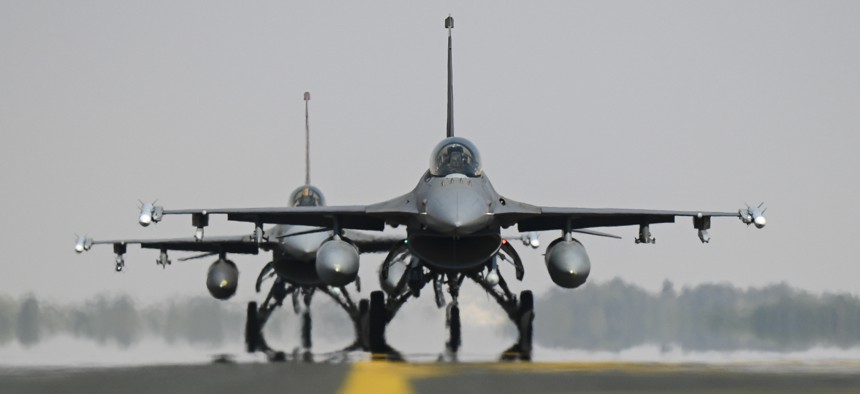
Two Air Force F-16 Fighting Falcons return from a mission in the U.S. Central Command region, March 6, 2023. U.S. Air Force / Tech. Sgt. Daniel Asselta
Russian pilots chill in Mideast skies after Pentagon’s name-and-shame effort
Air Force three-star says U.S. moves in the region have also deterred Iran and ISIS.
Russian planes aren’t provoking U.S. fighter jets over Syria anymore—marking a departure from hostility seen earlier this year, the region’s top U.S. Air Force official said.
“We did see, after we publicized some of their more egregious behavior, that that behavior [was] modified,” said Lt. Gen. Alexus Grynkewich, who leads Air Forces Central Command.
The general told Defense One in April that Russian warplanes were trying to dogfight American fighter jets. After more incidents of aggression, including the harassment of MQ-9 drones, the Air Force sent F-22s in July to the Middle East.
Russia’s behavior is still unprofessional, but it’s “safe,” Grynkewich told reporters Wednesday at a Defense Writers Group event.
“I would say that we've seen some favorable shifts in behavior over the last month that are broadly de-escalatory,” he said.
In addition to F-22s, the U.S. also sent F-35s, F-16s, and a Navy destroyer to the Middle East this summer to monitor Iranian activity in and around the Strait of Hormuz after Iran tried to seize commercial shipping vessels.
These moves deterred Iran from further actions against maritime shipping, Grynkewich said.
“Even as these forces go back—they were temporary, in the case of the F-35s in particular—if Iran thinks that that's an opening, the United States is absolutely willing to come back in and surge forces one more time,” Grynkewich said.
As for ISIS, Grynkewich said the group in Syria “isn’t something to worry about…we've got our boot on their neck, if you will.”
Yet he added that continued pressure is key: ISIS has a fair number of cells, senior leaders, and training camps that are beyond the area where coalition forces operate.
“My pitch to the Russians and to others who do operate in those areas is: instead of coming into At-Tanf Garrison and trying to assert that that airspace is not where the coalition operates, maybe you ought to focus on ISIS,” he said.
Grynkewich said other challenges persist in the region, including Iran’s effort to arm militia groups in Iraq, Syria, and Yemen.
Iran is sending a broad suite of weapons to these groups, including drones, close-range missiles, and small arms. The U.S. also continues to see Iran’s elite Quds Force training and advising these groups, he said.
Iran is providing these weapons to strengthen its network of proxy forces across the region, Grynkewich said.
“Iran likes being able to present that threat. They like being able to coerce other countries in the region. They haven't activated the network of late against U.S. forces,” he said.
Monitoring Iran and other hostile groups deters escalation, so the U.S. can stay focused on China, its primary competitor, Grynkewich said.
“If you want to distract us, even more broadly, a war with Iran would do that. And that would be catastrophic to the long term focus on China. So we're not looking for conflict with Iran. We're looking to deter that conflict, keep things de-escalated. And so by bringing a few forces in to de-escalate in the maritime domain, we can avoid worse outcomes later,” he said.
The general warned that China’s military could expand in the Middle East, as the country depends on the region for its oil and natural gas and is looking to strengthen economic ties through efforts like the Belt and Road initiative—China’s massive plan to build roads, power plants, ports, and other infrastructure across the world.
“They're trying to, in my view, displace our influence. They're primarily doing that through economic means and through the Belt and Road Initiative, trying to offer infrastructure projects, trying to offer in some cases foreign military sales or their equivalent of that, selling military hardware, but it's primarily an economic pathway,” he said.
Grynkewich said that where economic interests start, military interests will follow.
